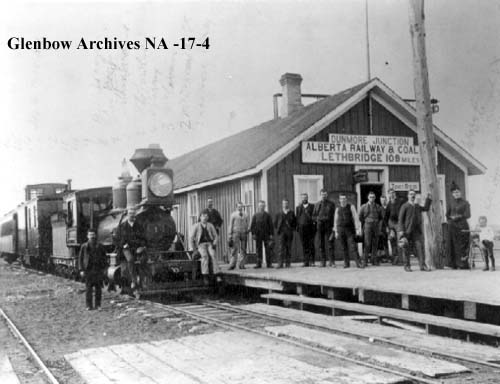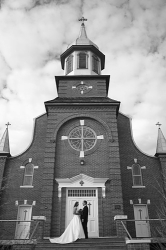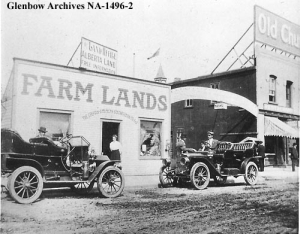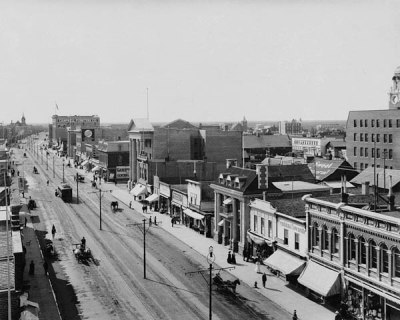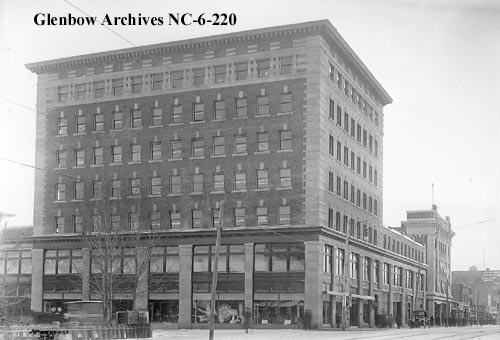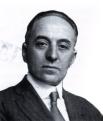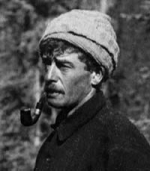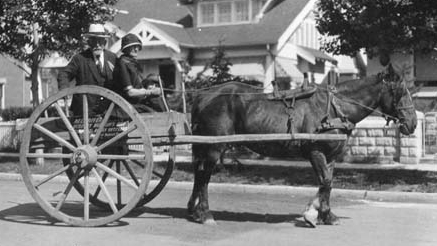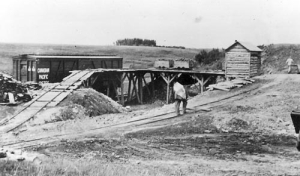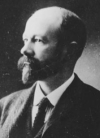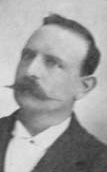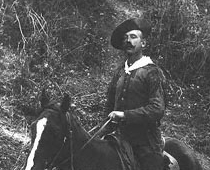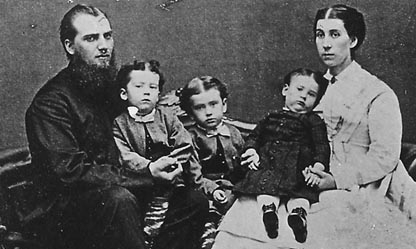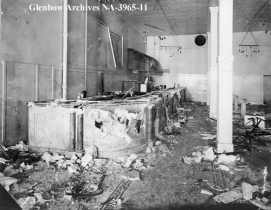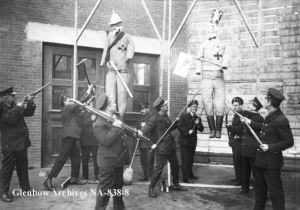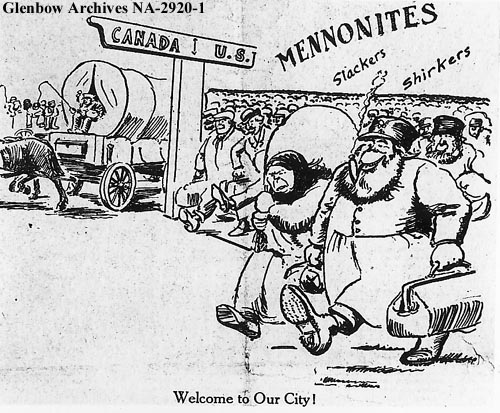
Overview of the immigration history of Alberta's German-speaking communities (Part 1: 1880s to 1914)The region in western Canada that would become Alberta was the last province to be settled by immigrants because it offered unique challenges of climate and isolation. When the settlers did arrive they were often not aware of the physical isolation which they would encounter in Alberta, the harsh weather conditions, and the amount of hard work required simply to survive the first few winters. The virtues of the Alberta prairies had been painted in such glowing colours by immigration agents that people were led to believe that ... free land, where a man might become rich overnight, awaited their plows, a land of temperate climate with the blessing of the Chinook, luscious grass belly-high to a tall horse, sod just waiting to be turned. [1] The reality was frequently different, especially for the early German settlers in the southeast corner of the province. Leaving homeIn the following four excerpts from the family histories of German-speaking immigrants, the homesteaders raise many issues which can be encountered repeatedly in the local and family histories of Alberta, and which may therefore be considered characteristic of the process of psychological separation from the old country and acculturation to the new. Among these issues are the following: although many settlers were glad to leave dusty, old Europe behind, there was—mixed with the eager anticipation of a better future—a sense of loss of what had been held dear for many generations. The immigrants really had no idea where they were going, nor how far removed from the rest of the world this virgin land of milk and honey was going to be. Only after they had arrived on this continent did the realization set in that Canada was indeed a foreign country with a new language and a new set of customs and values to be acquired. Furthermore, not all immigrants were poor: many settlers had left relatively comfortable homes behind in Europe. Small wonder then that some women, upon arriving at their home-to-be, often just sat down and cried. To be sure, there was ready willingness to change and adapt, but the homesteaders, especially in the far-flung rural settlements, stuck together and were always happy to meet other settlers in the village or the church with whom they could speak German, with whom they could share the stories of their pasts and apprehension about their futures. These men and women often were people without a country—not yet acculturated to Canada, but unable to return "home." For them, the German language was a vital link to the familiar world left behind. In his reminiscences, Fred Doll, son of a German-speaking old-timer from southern Russia, talks about leaving his farm and coming to Waterhole, a tiny hamlet near Fairview: It was on a warm day in June 1911 in the village of Sebastianfeld in Southern Russia, near the Black Sea, when my father came home from the village office where he served as a councillor. Among the mail he brought home that day was a letter... It was from a friend of my parents who had emigrated a few years earlier to America. Along with other news the friend wrote that land was plentiful and cheap; in fact, 160 acres could be had for just $10. My father said to mother, "I think, Maryann, we should emigrate to America." "But why should we emigrate?" she asked, "we have everything here, our folks, our friends, our home, just everything!" Finally it was decided that the two oldest boys of the family, brother Joseph with his wife Rosa and baby Monica and brother Frank, were to leave for America in the Fall and report home their findings. Almost a month later the first letter arrived from our world travellers and to our dismay it was all but enthusiastic. In his next letter, brother Joe described their arrival at Estavan [sic], Saskatchewan and their impression of the new country. They were to stay with relatives until they had located the "160 acres for $10.00" and then settle on it in the spring. It was around this time our emigrants made the dismal discovery that in this new land called Canada just about everyone spoke English. ... Besides our family there was my father's youngest brother, Uncle Frank and his wife Aunt Thekla with their family of five and their hired man, a Russian by the name of Conrad, were in our party to emigrate to America. Eventually we arrived in Bremen where we had to stay a few days before boarding the ship ... A train took us to the dock where the huge steamship S.S. Kaiser William II was anchored. The brass band on the steamer played the sad wanderer wails as only the Germans can play them: Muss i denn, muss i denn
zum staedele naus. And then: Now, adieu, my dear
homeland, dear homeland, adieu, Everyone was happy when we saw wheat and oats and cornfields again near Winnipeg. The scenery was very much the same as the steppes of southern Russia. A short time later a man stepped up on the platform and asked my father if we were the family of Joe Doll. He had been instructed by his brother to meet us when we arrived and direct us to two little houses which he had rented for us. We asked ourselves, "Where is this Peace River country?" It took brother Joe to find it, but he also found it was 350 miles from the nearest railroad (Athabasca Landing) and about 1,000 miles from Balgonie.... [2] But as time passed, the newcomers were gradually introduced to Canadian farm life. They met more people of German origin with whom they became close friends, and going to church they met many people who seemed happy and content with their lot. The oppressive sense of distance and isolation is evident in another homesteader's recollections who had grown up in Ladysmith, Quebec and would be among the first German women to settle in Alberta: Everything was new to me, I had not been on a train since the trip from Germany. ... We had to stop over Sunday in Winnipeg as trains did at that time not run on a Sunday. We went up to our room in the hotel. I threw myself on the bed and cried as I had never cried before. We left Winnipeg on Monday morning and got to Medicine Hat and from there on, a little narrow gauge (called turkey) train took us to Lethbridge, and on that train people were on the lookout for a glimpse of the Rocky Mountains. On the same train was a Methodist minister ... He asked me where I was going. I said Pincher Creek. "Well," he said, "you are going to the prettiest spot in Canada." But he said nothing about the wind. At Lethbridge my husband's partner or friend was waiting for us with a wagon and four horse team. After making some purchases the next day, we started for the 80-mile drive to Pincher Creek in a lumber wagon. It was a long lonesome drive and as far as the eye could see it was prairie and nothing but prairie and lovely little creeks and rivers which we had to ford. Fort Macleod was a dry stony little place and looked forlorn enough, and here the wind started to blow. I had hard work hanging on to my hat as it had no elastic, for where I came from, there was no wind... Well, we reached home... It was a pleasing sight, to be sure. The people who had been keeping house during my husband's absence moved out the next day, and I started to clean up the house and whitewash it. By the way, the house was the usual one-roomed shack with no stairs to climb and only one door. After I got through with the house it looked a good deal better, and as I had a lot of little nicknacks it began to look quite comfortable. Well, bit by bit, I learned things. I milked the cows, fed the pigs, and we bought some chickens. But it was lonely. If it had not been for the work that I had to do, I think I would have gone crazy. [3] An immigrant woman from [Tesa, Hungary] mused: We came from a fairly large town , according to European standards, with many fruit bearing trees, beautiful flowers, clean and well-kept houses and yards. I remember well the impression my sister and I had upon arrival at my father's house. Our shock was immense and almost unbearable. As we stood in the yard and observed this vast open prairie, where the naked eye could see for miles in any direction, we looked at each other and broke down crying for the things we had left behind. [4] ... relatives and friends [from Leipzig, Romania] would gather on street corners on afternoons, dressed in their traditional clothing with black shawls tied around their heads.... They spoke German and were very happy when some of the English speaking neighbors could speak German. They were all willing to learn the language and customs and adapted readily. This was home now. [5] Settling in southern AlbertaDetermining who is "German", is of "German origin", or has a "German heritage" in a country founded by generations of immigrants from many regions is notoriously difficult (click here for an extended discussion of the difficulties involved defining who or what is "German"). The current presentation means any "speaker of German" when it refers to "the Germans," which includes, of course, the Swiss, the Austrians, the Hutterites, the Russian-Germans, and many other groups. What about persons who had emigrated first to the U.S. and either continued on to Canada after only a short while or after several generations? Canadians of "German origin" from, say, 19th century Ontario (e.g., Mennonites or United Empire Loyalists) or from Nova Scotia (United Empire Loyalists) often did not identify with that heritage at all. It is obviously indefensible to subsume them under the "German" rubric. At best, one can say that their heritage was rooted in the German ethnic group. Take the following, for example: William Antrobus Griesbach was born at Fort Qu'Appelle, Saskatchewan on January 3, 1878, the son of RCMP Lieut.-Col. Arthur Henry Griesbach - the first man to be issued with a Northwest Mounted Police badge in 1873. In effect, his father was Canada's first Mountie. In “I Remember," published in 1946, Griesbach wrote that his father told him he was descended from a gang of "fiddlers" who came from Germany to England (Griesbach himself never referred to his German heritage). His father came to Canada in 1870. Griesbach's many accomplishments included distinction in military and civilian life and election as mayor of Edmonton in 1906 when he was just 28 years old. He was also commissioned as a lieutenant in the 19th Alberta Dragoons. When the Great War broke out in 1914, the 19th Dragoons volunteered as a unit and Griesbach was among the first to offer his services. He was heavily decorated for his services. After the war, he was promoted to Major-General, and he was elected as Member of Parliament for Edmonton West. In 1921, he was appointed to the Canadian Senate - a post he held until his death. He died on January 21st, 1945. The military barracks at Edmonton’s north end of the city were named for him. William H. Metzler, of United Empire Loyalist background, came to southern Alberta in 1880 as a member of the North West Mounted Police. After his retirement he settled in the Pincher Creek area. Nicholas D. Beck was born in Cobourg, Ontario, and educated in Peterborough where his father was Rector of the Anglican Church. He received his law degree from the University of Toronto. After moving to Winnipeg in 1883 where he practiced law, he entered the Catholic Church, briefly edited the Catholic weekly, the Northwest Review, and represented St. Boniface on the Senate of the University of Manitoba. In 1889 he moved to Calgary, then to Edmonton in 1891. Here he became Crown Prosecutor as well as City Solicitor, a position he maintained until his appointment to the bench in 1907. From 1893 to 1905 he also headed the emerging Edmonton Catholic School Board. In 1905 he was retained by the Dominion Government to advise on the Autonomy Bills for Alberta and Saskatchewan, especially the educational clauses. Beck was Chancellor of the University of Alberta from 1926 until his death two years later) Other Canadians with varying degree of German ancestry who lived and worked in Alberta around the turn of the century were: Dr. Leverett DeVeber (born in New Brunswick in 1849; member of the Legislative Assembly of the Northwest Territories and the Legislative Assembly of Alberta; appointed to the Senate) A. E. Snyder, an Inspector with the North West Mounted Police. He and his detachment were an important constituent in the Treaty Eight negotiations (1899), and he had strong bonds with the Native and Métis communities in northern Alberta. He made the first patrol of the Jasper area from Edmonton in 1897. Later (1905), NWMP Superintendent A. E. Snyder distributed samples of grain, grass seed, and potatoes to settlers in the Yukon which had been specially developed for the Canadian North at an experimental agricultural station. Rev. Leonard Gaetz (the "founder of Red Deer") John H. Kern (Justice of the Peace in Dunmore in 1891) Elias Shantz (homestead inspector in the Didsbury area) David Shantz (born in Waterloo County, Ontario. He came to Didsbury in 1901 where he was postmaster, justice of the peace and a member of the local school board) Charles W. Sutter (immigration official with the Dominion government in Edmonton; he was of great assistance to German immigrants) Dr. William Egbert (born in 1857 near Welland, Ontario; physician in Calgary. At the provincial election of March 22, 1909, Dr. Egbert was an unsuccessful Liberal candidate for Calgary. However, that same year, he was elected to the Calgary City Council for a two year term. Dr. William Egbert was a candidate for Mayor of Calgary in 1911, but was defeated. He served as President of the Alberta Provincial Federal Association from 1917-25, was President of the Calgary Board of Trade in 1918, was President of the Alberta Provincial Medical Association in 1921, and was President of the Alberta Liberal Association in 1924. He received an Honorary Doctor of Laws degree from the University of Alberta (1917). On the advice of Prime Minister William Lyon Mackenzie King, Dr. Egbert was appointed Lieutenant-Governor of Alberta effective October 29, 1925. Dr. William Egbert served as Lieutenant-Governor until his successor was appointed effective May 5, 1931. He died on October 15, 1936, at Calgary. William Puffer (born in North Crosby, Ontario; businessman, member of Lacombe town council and member of the Alberta Legislative Assembly) John Henry Foerster (born at Wellesley, Ontario; postmaster, member of town council and major of Stony Plain) Dan Brox (of German ancestry from Ontario; general merchant, cattle dealer and auctioneer in Spruce Grove. In 1905 he ran unsuccessfully in Stony Plain as a Conservative) Pincher Creek may be considered the first German settlement in Alberta. In 1883, Gus Neumann and Charles C. Schoening, both from Poplar Point west of Winnipeg, came to the area via the U.S. and settled some five miles south of Pincher. William Bradtke, who arrived in Canada from Germany in 1883 as well, filed on a homestead nearby; in 1884 he sent to Berlin for his wife and his child. And the Sweinfurts were also pioneer settlers coming from Germany in about 1883 and settling about one mile west of the Charles Schoenings. Two years later, more German Lutherans joined them. 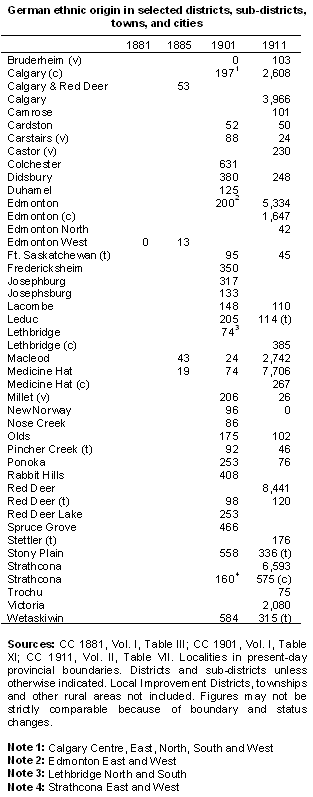
In 1884, another recent German immigrant, Emil Griesbach (who would become a prominent public and political figure in Gleichen), came to Calgary with the C.P.R., and in the same year the Reverend Leonard Gaetz, a Methodist minister, brought his family from eastern Canada to settle in the area of Red Deer, a city which he essentially founded. Clearly, other settlers of German origin must have arrived in the years following: While the 1881 Census did not report any Germans in Alberta, 19 persons of German ethnic origin were recorded in the Medicine Hat Sub-District in 1885, 43 in the Macleod Sub-District (which included Lethbridge), 53 in the Calgary and Red Deer Sub-District, and 13 in Edmonton Sub-District. But of these 128 ethnic Germans only 35 had been born in Germany; most of the others, would have come from Ontario and Manitoba as well as from the U.S. By the late 1880s, the first party of Mennonites was brought to the Gleichen area by Emil Griesbach. In 1888 a scouting party from Josephsberg and Brigidau in eastern Galicia arrived in southern Alberta and chose the area near Dunmore for their future settlement. In the following year, settlers arrived and founded three German colonies nearby. The majority of these Galician Germans was Lutheran, the remainder were Reformed. They were soon followed by Lutheran Germans from Volhynia. The Medicine Hat Times and the Edmonton Bulletin regularly reported on the immigrants' arrival with obvious interest: April 1889: German-speaking immigrants arrived in the Medicine Hat /Josephsberg area in April 1889 and September 1889. A total of about 400 families arrived that year. The German colony at Dunmore will soon be augmented by 64 families. September 1989: Another batch of German emigrants from Russia arrived a few days ago in Medicine Hat and went to a settlement about 15 miles from Dunmore. It is understood that this is just the advance guard, with a large body to follow in the summer of 1890. October 1890: 200 Russian-German immigrants left Russia about a week ago for the Medicine Hat district. They will take up homesteads south of Dunmore near the German colonies. November 1889: The Times reports on a visit to the German colony near Dunmore. The district organized will be known as Josephsberg school district. This colony has 350 inhabitants. Wonderful progress has been made, and there are no grumblers there. April 1890: A man from the German colony tells the Times that late-sown grain is a complete failure on the colony; fall-sown and spring-sown grain yields a far better crop. He denies reports that all the settlers will be leaving. The majority will put in at least another crop.
October 1890: The German settlement to the south of Medicine Hat does not appear to be a success because large numbers of them are leaving. Two bad seasons have appeared to discourage them. Representatives of the German colony near Dunmore have come to Edmonton to see what the district has to offer. Some 75 families want to leave Dunmore because of poor farming conditions. Most are from Galicia, but there are some of North German descent as well. They will likely settle in the Stony Plain and Horse Hill area. April 1891: 180 Germans leave Dunmore and head to Spruce Grove and Stony Plain. May 1891: 53 families (ca. 225 to 250 people) who came from Galicia two years ago have reached Edmonton with their belongings and their livestock and have left for their land on the Horse Hill plain. Ca. 25 families are still left at Dunmore. They are expected here soon. The German families who had arrived the previous week divided: Five Catholic families from Hungary will go to homesteads north of St. Albert. 25 families of Reformed Lutherans will homestead on the Horse Hill plain, and about 25 families of Old Lutherans are going to Stony Plain. The Baptists have not yet decided, but a few have already pulled out to the Peace Hills area. However, two years of drought forced the Dunmore settlers to look for land elsewhere and chose the area near Edmonton.
From 1895 to 1905, they spread through the entire Wetaskiwin-Camrose-Edmonton triangle. In 1893, German Baptists from Volhynia settled in the Leduc district and in nearby Wiesenthal, and in 1894 Germans from the Moravian Church in Volhynia started the Bruderheim and Bruederfeld colonies near Edmonton. German Lutherans from Galicia founded Hoffnungsau and Rosenthal near Stony Plain; German Reformed from Galicia founded Josephsberg (later, Josephsburg) near Fort Saskatchewan; and German Lutherans from Russia founded Heimthal and Lutherhort south of Edmonton. In November 1893, statistics on settlement in various German colonies in Alberta showed the following numbers: Josephburg (70), Hoffnungsau (380), Edmonton (300), Rabbit Hill (280), Leduc (175), Wetaskiwin (170), and Dunmore (42). December 1893: The German settlers (most of them from Galicia) in Stony Plain are doing very well. May 1894: Eight families of Germans from Volhynia arrived in Edmonton and will make their way to the land allotted to them about 40 miles east of Edmonton. These Moravians form part of 100 or so families for which Rev. Andrew Lilge has been trying to secure homes in this country. - Eight families of the Moravian colony from Russia are now in the immigration shed in South Edmonton. They are looking at locations. - Thursday's train brought 13 Germans to Edmonton. - Another party of Moravians from Volhynia are looking at land near Beaver River. If found unsuitable they will probably settle east of Egg Lake. July 1895: Several German families from East Prussia have arrived at Leduc and are taking up land. 20 families are here and more are on their way June 1898: A German newspaper report from Herrnhut relates the successful settlement experiences of hundreds of Volhynians in Bruederfeld (founded on June 27, 1895), Bruederheim (founded on July 26, 1896), and Heimthal (July 26, 1896). Brothers Hoyler and Schwarze are recruiting more settlers in Volhynia. Statistics at the end of 1896 show the following numbers: Josephsburg near Dunmore (70), Seven Persons (45), Gleichen (55), Lacombe (75), Leduc (650), the Wetaskiwin, Red Deer Lake and Bear Hills area (1,350), Rabbit Hills (180), Bruederfeld (210), Stony Plain and Spruce Grove (525), Beaver Hills (330), Bruderheim (100), Egg Lake (95)—alltogether nearly 3,700 persons.
German-American Catholics moved into the Pincher Creek area in 1896 and into the Spring Lake area in 1902. Between 1903 and 1905 people from old Mennonite settlements in Ontario and the U.S. went to the Didsbury district, where there had been Ontario Mennonites since 1893. Also after the turn of the century, a sizable number of German-Russian homesteaders, mostly Bessarabians, settled southeast of Medicine Hat in farmland stretching towards the Cypress Hills. And, Rosenheim in east-central Alberta was founded in 1911 as an extension of the German Catholic St. Joseph's Colony in Saskatchewan. In 1901, the Census showed an increase from some 900 persons of German origin in 1891 to 7,836. By 1911, eleven percent of Alberta's population was of German origin (N=36,862); another 7,767 Albertans reported Austrian origin. Most of the immigrants of German origin lived in the rural areas. Edmonton's directory for 1895, for instance, shows only 14 German-sounding last names, out of a total of 561 names including businesses. Moving northThe spread of the German settlers to central and northern Alberta can be seen readily in the following table. In 1937, Elizabeth Gerwin (a student in the Department of Modern Languages at the University of Alberta in Edmonton [6]) compiled the following list of approximate dates when significant numbers of "Germans" had moved to certain areas of the province.
Click here for maps showing the location of German settlements in urban Alberta as well as Hutterite and Mennonite colonies. German social, economic and cultural life in urban Alberta between ca. 1900 and 1914The "Germans" who had moved to the towns and cities of Alberta had access to a number of German-speaking clubs and associations, businesses and churches there. The German-language Alberta Herold informed its readers about current events in Europe, commented on what was happening in North America, and ran columns and letters from readers in rural Alberta.
It also contained many advertisements directed at the German-speaking population of Alberta. Real-estate agencies offered good farmland in the Leduc district, pointing out that there was a German settlement there [7]; two department stores in Strathcona praised their wares ranging from foods to clothing articles. [8] A German bookstore was set up in Edmonton in 1905 [9], and later a greater selection of German books was available directly from the Herold [10], and for $4.05 a person could buy the most recent model of the Edison Phonograph. [11] The Dreamland Theater on Jasper Avenue in Edmonton showed "first-class moving pictures, the best entertainment for young and old," and the Starland Theater, calling itself a family theatre, advertised a similar fare in bewegliche Bilder [moving pictures], for example, Die letzten Tage von Pompeii [The Last Days of Pompeij]. [12] In Edmonton, the German choir Germania publicized its New Year celebration in large advertisements, and great play was given to the visit to the Edmonton Opera House by Mme. Langendorff who—according to the advertisement—was the favorite singer of His Majesty, the Emperor. [13] Offering a different kind of entertainment, Ferdinand Koch, a German championship wrestler, visited the Edmonton area. [14]
Clubs were founded in many locations; some were active for a long time, others folded again soon. For example, Club Edelweiss (founded in 1905) indicated that it was open every day from 2 p.m. to 11 p.m., [15] and in Calgary, Club Harmonie (founded in 1906) welcomed members and non-members alike to its Club Hall. [16] The Russisch-Deutscher Verein was set up in Edmonton in 1908, [18] as was the Deutsch-Canadischer Concordia Verein. [19] The Germania Choir was founded one year later. [20] But German clubs were not limited to the major centres: The Deutscher Verein Morinville und Umgebung was established in 1906, [21] and in 1910 the Male Choir Saxonia was founded in Irvine. [22] The Deutsche Vereinigung von Brouse, which also had health and death insurance as a social objective, was set up in Calgary in 1910. [23] 1912 saw the establishment of the German Club Frohsinn in Calgary. [24] The first German concert in Edmonton was given in 1908, [25] and it was announced in the same year that German literature would be taught at the University of Alberta which had been founded in 1905. [26] The first German restaurant in Edmonton was opened in 1911 in the Royal Hall [27] as well as a German meat market. [28] In 1913, the first German dentist hung out his shingle [29], and in the same year a German lending library was founded in Edmonton. [30] Founded in 1903, the weekly Alberta Herold was not the only German newspaper published in Alberta at that time. In 1907, the Deutsch Canadier was founded, and in 1909 the Deutsch-Canadier published a weekly supplement, the Deutsch-Canadischer Farmer. In 1910, Gustav Koermann—former editor of the Herold—founded the Alberta Deutsche Zeitung. [31] Economic advancement"The Germans" made economic advances in this time period. Among the successful businesses and businessmen were the following:
Robert Tegler came to Edmonton in 1901 from the German settlement around Walkerton, Ontario. He had majored in mathematics at the University of Toronto and wanted to continue with a Master's degree, but his health broke down and he had to do something else. So he brought a load of cattle out to Wetaskiwin to sell. He decided that Edmonton had a great future and stayed. He worked at anything, but soon had his mind set on building a large office building at the corner of 101 Street and 102nd Avenue. He was told he was crazy, but he stuck with it and spent the rest of his life paying for what he built. The Tegler Block was all reinforced steel, the first fireproof office building in Edmonton. He died a millionaire in 1921 at the age of 41 and left the profits of the Tegler Building to worthy causes.
Probably the most successful German businessman at the time was Martin Nordegg. Nordegg (1868-1948), a native of Silesia. was an investment syndicate representative and manager at Nordegg, Alberta and Ottawa, Ontario. He became highly successful as a coal mining developer ("German Development Company") between 1906, the year of his arrival in Canada, and 1914. He traveled widely in Alberta, prospected for coal and established and exploited coal fields in the Bighorn and South Brazeau Rivers and Kananaskis regions in southwestern Alberta. He founded the town bearing his name. Nordegg traveled in the circles of high finance and politics in Canada, England and Germany prior to the First World War, but moved to the United States during the war to avoid harassment due to his German nationality. He divested himself of his western Canadian interests upon his return.
Conrad Kain (1883-1934), born in Nasswald, Austria, achieved prominence in an altogether different area. He received his first guiding job on a local cliff near his home town and after five seasons of extensive climbs he was invited to become the first official guide of the Alpine Club of Canada (1909), based in Banff, Alberta. In addition to guiding wealthy climbers in Canada and abroad, he was an assistant to early surveying teams at the Rogers and Yellowhead passes. He built the first ski jump in Banff (1911), ushering in the sport of recreational skiing, and led the first ascents of Mount Robson (1913) and Mount Farnham (1914), highest mountains in the Canadian Rockies and Purcells, respectively. His solo snowshoe ascent of Mount Jumbo (1919) was the first winter ascent above 3350 m in Canada and his last climb, in the Purcells, was of a 3352 m peak (1933) which later came to be called Mount Conrad. The Germans' involvement in municipal, provincial and federal politicsThe Germans struggled—and sometimes succeeded—to gain a profile in politics. At issue was always the question, however, whether the Germans should vote only for a German candidate because of his ethnicity, or whether they should vote for the person who would most likely represent their interest, even if he were English. ("For the imminent provincial election the Alberta Herold recommends that German voters vote for the English-speaking Liberal who is known to be friendly to German interests rather than for an incompetent German whose only virtue is to be German" [47]). In general, the Germans tended to vote Liberal, and Liberal associations were established in Stony Plain (1908) and Edmonton (1909), [48] Calgary (1911), [49] and Medicine Hat (1913). [50] In 1907, the Liberal Party moved to have Alberta's laws translated into German as promised two years earlier [51] —a project that was not completed except for a translation of the school laws and certain local improvement laws.
Local and municipal politics (click for details on the political successes in Edmonton and Calgary)As early as 1901, Ray Gaetz was elected mayor of Red Deer (probably the first mayor of German descent in an Alberta town). In 1904, Heinrich Vockeroth became mayor of Irvine (he had come to Josephsberg 15 years before). [52] The Viennese Stephan Swoboda became the first mayor of Wetaskwin in 1906 as did Clarence W. Gaetz of Leduc, and Jacob Miller in Stony Plain in 1909. In 1907, Israel Umbach (1867-1948) was elected overseer and sheriff of the new settlement of Stony Plain. At various times, he also served as tax collector and constable. Umbach was born in Woolwich, County of Waterloo, Ontario, in 1867. He moved to Edmonton in 1892 and soon homesteaded in the Glory Hills west of the city. A carpenter by trade, he built, amongst others, the first livery stable, the town fire hall, a school building, the Glory Hills Reform Church and many other homes and businesses in the area. He was also made the first trustee of the Stony Plain Village School in 1908. John Henry Foerster was born at Wellesley, Ontario, in 1872. In 1905 he left Stratford, came to Edmonton and filed for homestead southeast of Stony Plain. In 1907 he took over the post office in Stony Plain, being the only one with a Grade VII education, and operated it until his death in 1927. Over the years he served as town councillor (1908-), mayor of Stony Plain (1915-1919), official auditor (1908-1932) and Justice of the Peace. Jacob Miller was born in Galicia in 1879. He came to Canada in 1890 with his parents. Their first stop was in Dunmore near Medicine Hat, and in 1892 they moved to Stony Plain. He was the town's first storekeeper and postmaster and later its second mayor (1909-1911). Subsequently he tried various other enterprises, among them farming. Jacob Miller died in 1962.
Emil Griesbach was born in Saxony on March 20, 1855. At the age of 27, he came to Winnipeg, and from there worked on the railroad during the construction of the Canadian Pacific west through Alberta. In 1887 he established the first lumber yard at Gleichen, which he owned until 1908. He also owned a general store and was the manager of the Revelstoke Lumber Company for several years. Soon after completion of the transcontinental railroad in the Gleichen area, in 1886-87, his articles about the area published in German newspapers were the starting point of Mennonite migration to this area of Alberta. He assisted in locating 1,443 homesteads for them, and during the very dry season of 1888-89 he located most of these settlers at Didsbury. Griesbach also helped in the settlement of Germans in the vicinity of the town of Bruderheim. Emil Griesbach was mayor of Gleichen and was an - unsuccessful - candidate in the provincial elections in 1913. He died in 1939 in Gleichen.
Carl Stettler was born near Bern, Switzerland, on June 7, 1861. After traveling and working across Europe and the U.S., he came to Alberta in 1903. From Red Deer he investigated the surrounding country and finally located a homestead two and a half miles east of the present town of Stettler. There he became the founder of the Swiss and German colony of Blumenau in 1905. In the same year, the building of the railroad required moving the entire townsite to the site of Blumenau. Stettler became postmaster of the new town, also was a Canadian Pacific land agent there, and the town was named in his honor. He built and owned the National Hotel in Stettler and two other hotels in Castor. He was a member of the first Town Council of Stettler, and later he organized the Castor Coal Company. Provincial politics
In Alberta's first provincial election in 1905, Cornelius Hiebert (a German Mennonite from Russia) was elected as a Conservative in the Rosebud district. He was born in the south of Russia, Sea of Azov, on August 2, 1862. He attended school there until he was 13 years old and then came to Manitoba with his parents. After leaving school, Hiebert worked in the general store business in Manitoba for several years and owned a number of businesses. In 1900 he came to Didsbury and ran a general merchandise, lumber and implement business. He was overseer of the village of Didsbury from 1901 to 1904. In 1905, he was elected a Conservative member to the Provincial Parliament from the Rosebud constituency and served until 1909. He ran again as an Independent in 1909 and finished a distant third. Hiebert was also one of Alberta's very successful early German-speaking businessmen. J. E. Stauffer, a Liberal representing the
constituency of Didsbury in the Alberta Legislature, defeated Hiebert who ran as an independent in 1909 and was re-elected in 1913.
He was killed in the war in 1917. Stauffer was of
Swiss origin. [55]
Anthony S. de Rosenroll was born at Castellamare, in southern Italy, on December 4, 1857. After touring Canada and the U.S. he came to Alberta and settled in Wetaskiwin in 1896, when the town had but 32 inhabitants. He was a rancher, owned a lumber company, owned a stock and grain farm at Rosenroll, a town 16 miles east of Wetaskwin named after him, and had great interest in coal. He achieved success in the dairy business, but then became active in real estate and the insurance industry as well. Rosenroll represented the constituency of Wetaskiwin as a Liberal in the Alberta Legislature from 1905 to 1909. He was first elected to the legislature of the Northwest Territory in 1898. In 1909 De Rosenroll was endorsed by the German-speaking community as the Liberal candidate for Strathcona for the Dominion Parliament. He died in 1945. Dr. Leverett DeVeber was born in New Brunswick in 1849; his (distant) ancestors were likely German or Alsatian. Prior to moving out west, he was educated at the University of Pennsylvania and worked at St. Bartholomew's Hospital in London. In 1883 he arrived in Fort Macleod and became a surgeon for the North West Mounted Police. In 1891 he was elected to the Legislative Assembly of the Northwest Territories and was re-elected in 1902. Dr. DeVeber served in the Legislative Assembly of Alberta for the Alberta Liberal Party in the Lethbridge Provincial electoral district from 1905 to 1906. In that short time he served as a cabinet minister in the Alexander Rutherford government. In 1906 he was appointed to the Canadian Senate. He was appointed by Prime Minister Sir Wilfrid Laurier and represented the (Lethbridge) Senate division as a Liberal until his death. DeVeber passed away in 1925, in Aylmer, Quebec.
William Puffer was born in 1861 at North Crosby, Ontario and died in 1948 at Lacombe, Alberta. He was the son of a United Empire Loyalist, came to Alberta in 1889 and homesteaded in the Olds district. He was later engaged in the cattle and lumber business, moving to Lacombe in 1893. Puffer was a director of the Lacombe General Hospital and of the Lacombe Creamery Ltd. A member of the school board from 1893 to 1894 and 1896 to 1902, he was a member of the town council from 1903-1906. Puffer represented Lacombe in the Alberta Legislative Assembly as a Liberal from 1905 to 1917. In the 1909 elections, Alfred von Hammerstein, a wealthy German-Albertan businessman and great supporter of German culture in the province since 1897, was a candidate for Athabasca, but withdrew his name two days before the elections. [54] Von Hammerstein, [ca.1870]-1941, was born in Germany, and as a young man embarked on a military career. In 1895 he gave this up and moved to New York. In 1898 he headed for the Klondike gold rush via Edmonton, but turned back before reaching the Yukon. Instead, he joined another adventurer and traveled down the Athabasca River to Fort McMurray. Here he first encountered the Athabasca Tar Sands, which he later attempted to develop. Between 1898 and 1907 he ran German language newspapers in Edmonton and Winnipeg. Among other ventures he founded the Alberta Herold in Edmonton in 1903, which he later sold to Gustav Körmann.
In 1907 he took a drilling crew to Fort McMurray and spent the next five summers drilling. He was unsuccessful in finding a way to extract the oil from the sand. Yet he raised millions, and with this money founded the Athabasca Oil and Asphalt Co. in Winnipeg in 1909. At the beginning of World War I von Hammerstein tried to return to Germany but was captured and interned. He was an outspoken defender of the Germans in Canada and protested the measures imposed on the enemy aliens. He also founded the Canada First Movement which advocated an isolationist policy - the principle to remove all foreign influences which might endanger the good relationships among the various ethnic groups in Canada. He was willing to try to represent the interests of tens of thousands of German-Canadians in Parliament in 1915, running on the Canada First platform if there was sufficient public moral and financial support in the community. He traveled extensively, received many letters but little financial support, and therefore did not run in the election. Von Hammerstein visited Alberta several times in the 1930s. In 1939, he applied to the Dominion minister of defence for permission to organize a German-Canadian anti-Nazi batallion in Alberta. His request was refused by the Department of Defence because this would have violated existing policy, but the Department expressed its appreciation for the effort. In 1913, In Stony Plain, the Germans elected the Conservative Conrad Weidenhammer because the Liberal candidate (J.A. McPherson) was English. [56] He was born in Ontario of German immigrant parents on January 27, 1866 and came to be a prosperous Spruce Grove farmer. He served for only one term and retired in 1917. Peter Enzenauer was a three-term MLA from 1921 to 1935 for the electoral district of Alexandria (bordering Saskatchewan around Lloydminster) for the United Farmers of Alberta. He had moved here from Illinois in 1904, homesteaded at first in the Vulcan area and then bought a ranch near Kitscoty. Enzenauer's parents had come from Germany. Federal politicsThe only - vaguely - German-Albertan involved in Dominion politics was the above-mentioned Dr. Leverett DeVeber who was elected in 1891 to the Legislative Assembly of the Northwest Territories and was re-elected in 1902. He served in the Legislative Assembly of Alberta for the Alberta Liberal Party in the Lethbridge Provincial electoral district from 1905 to 1906 when he was appointed to the Canadian Senate representing the (Lethbridge) Senate division as a Liberal until his death. Unsuccessful candidatesThere were a number of candidates of German origin who did not get elected to a municipal or provincial seat —sometimes only by a small margin; for example:
The German-language newspapers gave the following as the main reasons for the Germans' lack of political success:
The German-language papers themselves often endorsed English candidates, for example, in the Dominion elections in Calgary in 1910 I.A. McArthur was endorsed by the Deutsch-Canadier. He was elected, and the newspaper claimed that the German vote in Riverside made the difference. In 1913, the Deutsch-Canadier endorsed Geo. H. Ross as the candidate for Calgary North maintaining that Ross was known and respected by the Germans in the area. He was elected, and it turned out that at least three quarters of the Germans voted for him. On the other hand, the Deutsch-Canadier strongly endorsed Charles Pohl and two "English" candidates (Dr. Egbert and Commissioner Clark) for the Calgary City Council in the 1911 municipal elections and strongly emphasized Pohl's German ethnicity, but to no avail. The German-speaking community in Alberta during and after the First World WarBefore the War, German-Albertans took pride in the contributions that they had made to Canadian society; their businesses were flourishing, and they took the first tentative steps towards representation of their interests on the municipal level by participating in municipal elections. Still, there were many voices that complained about the disunity of the German-speaking community and urged the German speakers to maintain their language and culture. More organizations were founded to bring "the Germans" together so that they might speak with a common voice.
Between August and September 1914, there were frequent calls in the English-language newspapers to "treat the Germans fairly"; after all, the War was not theirs, nor was it of their making. But soon, the first arrests of "Germans" and "Austrians" as prisoners of war were made, and paranoia set in about possible German sabotage in Canada. Enemy aliens had to register themselves, their firearms were confiscated, and internment camps were established in several locations in Alberta. Some of the German-language newspapers in Alberta—either outspokenly pro-German or moderate in their views—were accused of treason, and calls were made for the "suppression" of the worst "offenders." Oveer the course of the next few years, several localities and post offices that had been founded by German speakers and had German-sounding names changed them for "patriotic reasons," for example, Bingen P.O. (changed to Nemiskam in 1916), Carlstadt (to Alderson in 1915), Düsseldorf (to Freedom in 1919), Griesbach (to Carseland in 1914), Wiesville P.O. (to Aspen Beach in 1916), and Wittenburg P.O. (to Leedale in 1917). [Click here for a complete list of German place names and topographical names in the province of Alberta, and an explanation of their origin.] The registration of enemy aliens proceeded orderly with only very few arrests for violating the registration regulations. Most of the arrests were quite frivolous and unjustified, and were overturned on appeal. One of the German-language newspapers which had not yet folded shrilly urged the Germans to "stick together" and railed against the "war" against the Germans in Canada, but exhorted them to obey the registration laws. Between January 1915 and 1916, an attempt was made to organize the Germans and other groups in a Canada First Movement by a certain Alfred von Hammerstein, but this effort met with little response from the rather reluctant Germans in the province. There were a few successful escapes from internment camps that provoked paranoia about the help that the escapees had allegedly received from "German spies."
The anti-German mood came to a head in February 1916 when anti-German mobs roamed the streets in the German quarters of Calgary and trashed several German-run establishments under flimsy and false pretexts. Subsequently, municipalities purged their employment rolls of "Germans"— even naturalized ones— although they had not committed any offences. Certain groups of enemy aliens were disenfranchised altogether, and the one remaining German-Albertan newspaper was forced to publish in English.
From early summer 1918 on, there were occasional reports of "Germans" entering Alberta from the U.S. and buying up huge tracts of fertile farmland in the south. These "Germans," the Hutterites, were met with great hostility because of their anti-war convictions, their land purchases, and their clannishness and refusal to integrate in Canadian society.
The Lethbridge Daily Herald reported on August 7, 1918 that 5,000 acres at Raley were sold to a colony of Hutterites for a price well up into the six figures. An American guest speaker at a local Chatauqua talked about the firm grip which the Germans and the German language had obtained in the U.S. through insidious propaganda. This was being wiped out, he said. He hoped that the time was coming when the German language would not only be wiped out in his state, but also from the face of the earth entirely. — The Calgary Eye Opener objected to the mass immigration of Hutterites. The government should do something about them before the people do. "WHY DO THEY WANT TO IMPOSE SUCH A BUNCH OF GERMAN CATTLE ON US? That gets our goat. WHY?" — In an editorial on September 12, 1918, the Lethbridge Daily Herald argued that "people who disclaim responsibility for the defence of the country that protects them are not desirable citizens. Neither are people who attempt to segregate themselves from others and send their children to schools of their own where they do not come into contact with other children and where they are taught another language and refrain from learning the language of the country in which they are living. These people must not be given one single special privilege." Click on the "1918 to the present" button on the left to continue with the overview of the immigration history of Alberta's German-speaking communities Notes[1] Mrs. Ron Milne, "The Lone Pine story," in Bucking poles and butter churns: History of Lone Pine and district (Didsbury: North Lone Pine Women's Institute, 1972, p. 44. [2] "Fred Doll," in Hec MacLean, ed., Waterhole and the land north of the Peace (Fairview: Oldtimers' Association, 1970), pp. 41-42. [3] "Grandma Schoening's Diary," in Prairie grass and mountain pass: History of the pioneers of Pincher Creek and district (Pincher Creek: Pincher Creek Historical Society, 1974), pp. 376-377. [4] Jolan Keller Inkpen, "The Jo Keller Story," in Jean James, ed., Hanna north (Hanna: Hanna North Book Club, 1978), pp. 730-731. [5] Emma Wiege Burgemeister, "The Wiege story," in James, p. 616. [6] Elizabeth B. E. Gerwin, A survey of the German-speaking population of Alberta. M.A. Thesis (Edmonton: University of Albera, 1938) [7] Alberta Herold, March 2, 1911. [8] Alberta Herold, October 1, 1909. [9] City of Edmonton Archives, EA-267-235. [10] Alberta Herold, February 2, 1911. [11] Alberta Herold, September 29, 1910. [12] Alberta Herold, October 8, 1909. [13] Alberta Herold, December 17, 1909. [14] Alberta Herold, December 4, 1908. [15] Alberta Herold, October 2, 1909. [16] Alberta Herold, October 8, 1909. [18] Alberta Herold, January 17, 1908. [19] Alberta Herold, February 14, 1908. [20] Alberta Herold, April 17, 1908. [21] Alberta Herold, February 23, 1906. [22] Alberta Herold, March 17, 1910. [23] Der Deutsch-Canadier, September 8, 1910. [24] Der Deutsch-Canadier, April 11, 1912. [25] Alberta Herold, February 14, 1908. [26] Alberta Herold, May 15, 1908. [27] Alberta Deutsche Zeitung, January 19, 1911. [28] Alberta Deutsche Zeitung, May 25, 1911. [29] Alberta Herold, June 19, 1913. [30] Alberta Herold, July 24, 1913. [31] Der Deutsch-Canadier, October 27, 1910. [32] Alberta Herold, ??. [33] "Christian Bartsch," in MacRae, Archibald Oswald, History of the Province of Alberta (s.l.: Western Canada History Company, 1912), pp. 975-976. [34] "William August Max Vogel," in MacRae, Archibald Oswald, History of the Province of Alberta (s.l.: Western Canada History Company, 1912), pp. 694-695. [35] Der Deutsch-Canadier, February 29, 1912. [36] Der Deutsch-Canadier, June 12, 1913. [37] Alberta Herold, July 10, 1913. [38] Alberta Deutsche Zeitung, November 21, 1912. [39] Photo. Glenbow Library and Archives, Calgary. NC-4-14. [40] Der Deutsch-Canadier, April 22, 1909. [41] Photo. Glenbow Library and Archives, Calgary. na-4174-41. [42] Alberta Deutsche Zeitung, January 26, 1911. [43] Der Deutsch-Canadier, October 27, 1910. [44] Der Deutsch-Canadier, June 12, 1913. [45] Alberta Deutsche Zeitung, May 25, 1911 . [46] Der Deutsch-Canadier, September 30, 1909. [47] Alberta Herold, September 15, 1905. [48] Alberta Herold, February 5, 1909. [49] Der Deutsch-Canadier, August 24, 1911. [50] Alberta Herold, February 27, 1913. [51] Alberta Herold, December 10, 1909. [52] Der Nordwesten, July 14, 1904. [54] Der Deutsch-Canadier, September 30, 1909. [55] "Joseph Emmet Stauffer," in Archibald Oswald MacRae, History of the Province of Alberta (S.l.: Western Canada History Company, 1912), p. 451. [56] Der Deutsch-Canadier, April 24, 1913. [57] Volksdeutsche refers
to Germans who lived outside the eastern boundaries of the German Reich;
Reichsdeutsche to Germans living within the boundaries of the German Reich before 1938. [58] Alexander Malycky and Clive H. Cardinal, "German-Canadian periodical publications: A preliminary checklist," Canadian Ethnic Studies, Vol. 1 (1), 1969, 13-30. [59] Central Baptist Church, Edmonton, Alberta: 75th Anniversary, 1900-1975 (Edmonton: 1975), p. 7. [60] John E. Herzer (ed.), Homesteading for God: A narrative history of Lutheran mission work in Alberta and British Columbia, 1894-1946 (Edmonton: Commercial Printers, 1946), p. 64. [61] Verhandlungen der Deutschen Evangelisch-Lutherischen Synode von Manitoba und anderen Provinzen (Saskatoon: 1958), p. 82. Photo credits"The first church in Bruderheim, Alberta, in the early 1890s". From Gerhard P. Bassler (transl. and ed.), Heinz Lehmann: The German-Canadians 1750-1937 (St. John's, Newfoundland, Jesperson Press, 1986). Image 4 after p. 368. Rosenheim Church: Digiteyesed Photography. http://www.digiteyesed.com/gallery/ album10/zjwedding_churchformals_15_sm. Accessed on October 21, 2004. "German Days 1932 held on August 4 in the Victoria Park, Edmonton." Glenbow Archives, Calgary, Canada. D-3-6181. Used with permission. "German immigrants." Glenbow Archives, Calgary, Canada. na-1960-1. Used with permission. "German-Canadian Cultural Center, Roper Road, Edmonton." Arnim Joop, June 2000. Used with permission. |

